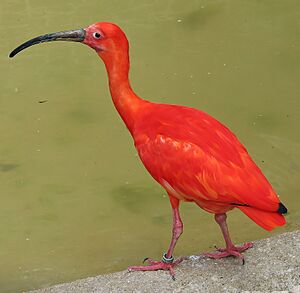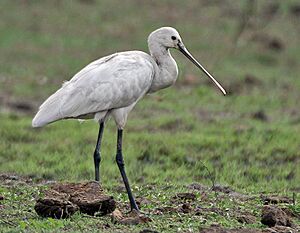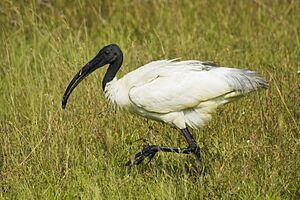Threskiornithidae facts for kids
Quick facts for kids Threskiornithidae |
|
|---|---|
 |
|
| Scarlet ibis | |
| Scientific classification |
|
| Kingdom: | Animalia |
| Phylum: | Chordata |
| Class: | Aves |
| Order: | Pelecaniformes |
| Suborder: | Ardei |
| Family: | Threskiornithidae Richmond, 1917 |
| Subfamilies | |
The Threskiornithidae family is home to 36 types of large wading birds. These birds are often called ibises and spoonbills. For a long time, scientists grouped them into two main subfamilies. However, newer studies looking at their genes suggest that spoonbills might actually be a type of ibis from the "Old World" (like Europe, Asia, and Africa). The ibises from the "New World" (the Americas) seem to be an older, separate group.
Contents
Bird Families: How Scientists Classify Them
The Threskiornithidae family used to be known by a different name, Plataleidae. Scientists once thought ibises and spoonbills were related to other long-legged wading birds. These birds were placed in an order called Ciconiiformes.
But new studies have changed this idea! Scientists now believe these birds belong to the order Pelecaniformes. This is the same group that includes pelicans. The International Ornithological Congress (IOC) officially moved them to this new order.
Scientists are still learning about how ibises and spoonbills are related. They use mitochondrial DNA (a special part of their cells) to understand their family tree. These studies show that spoonbills are closely related to some Old World ibises. New World ibises, like the Scarlet ibis, are a bit more distant relatives. This means the old way of dividing them into just two subfamilies might change as we learn more.
What Do Ibises and Spoonbills Look Like?
These birds have long, wide wings. They have 11 main flight feathers and about 20 smaller ones. They are strong flyers and can even soar high in the sky, which is amazing for their size!
Their bodies are long, and their necks are even longer. They also have very long legs. The most unique part is their bill. Ibises have a long, curved bill that points downwards. Spoonbills have a straight bill that is flat and wide at the end, shaped like a spoon!
These are large birds, but they vary in size. The smallest is the dwarf olive ibis, which is about 45 centimeters (18 inches) tall and weighs around 450 grams (1 pound). The biggest is the giant ibis, which can be 100 centimeters (39 inches) tall and weigh up to 4.2 kilograms (9.3 pounds).
Where Do They Live and What Do They Do?
Ibises and spoonbills live almost all over the world. You can find them near still or slow-moving fresh water, or even salty water. Ibises can also be seen in drier places, like near landfills.
A special place called the Llanos in South America is home to seven different types of ibises!
All ibises and spoonbills are active during the day. They spend their time looking for food. They eat many different small invertebrates (like insects) and small vertebrates (like fish). Ibises use their curved bills to probe in soft earth or mud to find food. Spoonbills swing their flat bills from side to side in shallow water to catch their meals.
At night, these birds rest in trees near water. They like to be with other birds, so they often feed, rest, and fly together. Sometimes they even fly in cool formations!
Nesting and Life Cycle
Ibises usually build their nests in large groups called colonies. Spoonbills might nest in smaller groups or even alone. They almost always build their nests in trees that hang over water. Sometimes they build them on islands in swamps.
The female bird builds a big nest using reeds and sticks that the male bird brings to her. They usually lay two to five eggs. The eggs hatch at different times, not all at once. Both parents take turns sitting on the eggs to keep them warm.
After the chicks hatch, both parents feed them by bringing up partially digested food. When the young birds are two or three weeks old, they don't need to be kept warm all the time. They might leave the nest and join other young birds in groups called "creches." But they still come back to their parents for food.
Species of Ibises and Spoonbills

FAMILY: THRESKIORNITHIDAE
- Subfamily: Threskiornithinae – Ibises
- Genus Threskiornis
- African sacred ibis, Threskiornis aethiopicus
- Malagasy sacred ibis, Threskiornis bernieri
- †Reunion ibis, Threskiornis solitarius (extinct)
- Black-headed ibis, Threskiornis melanocephalus
- Australian white ibis, Threskiornis molucca
- Solomons white ibis, Threskiornis molucca pygmaeus
- Straw-necked ibis, Threskiornis spinicollis
- Genus Pseudibis
- Red-naped ibis, Pseudibis papillosa
- White-shouldered ibis, Pseudibis davisoni
- Genus Thaumatibis
- Giant ibis, Thaumatibis gigantea
- Genus Geronticus
- Northern bald ibis, Geronticus eremita
- Southern bald ibis, Geronticus calvus
- Genus Nipponia
- Crested ibis, Nipponia nippon
- Genus Bostrychia
- Olive ibis, Bostrychia olivacea
- São Tomé ibis, Bostrychia bocagei
- Spot-breasted ibis, Bostrychia rara
- Hadada ibis, Bostrychia hagedash
- Wattled ibis, Bostrychia carunculata
- Genus Theristicus
- Plumbeous ibis, Theristicus caerulescens
- Buff-necked ibis, Theristicus caudatus
- Black-faced ibis, Theristicus melanopis
- Genus Cercibis
- Sharp-tailed ibis, Cercibis oxycerca
- Genus Mesembrinibis
- Green ibis, Mesembrinibis cayennensis
- Genus Phimosus
- Bare-faced ibis, Phimosus infuscatus
- Genus Eudocimus
- American white ibis, Eudocimus albus
- Scarlet ibis, Eudocimus ruber
- Genus Plegadis
- Glossy ibis, Plegadis falcinellus
- White-faced ibis, Plegadis chihi
- Puna ibis, Plegadis ridgwayi
- Genus Lophotibis
- Madagascar ibis, Lophotibis cristata
- Genus Threskiornis
- Subfamily: Plataleinae – Spoonbills
- Genus Platalea
- Eurasian spoonbill, Platalea leucorodia
- Black-faced spoonbill, Platalea minor
- African spoonbill, Platalea alba
- Royal spoonbill, Platalea regia
- Yellow-billed spoonbill, Platalea flavipes
- Roseate spoonbill, Platalea ajaja
- Genus Platalea


